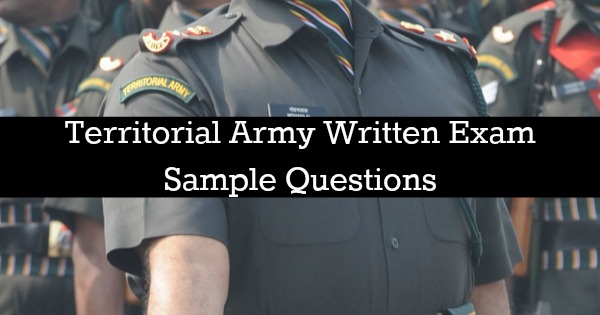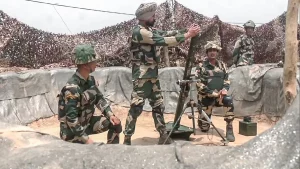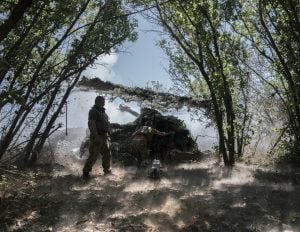Ex Service Officers will be selected by Territorial Army 1 2016 written exam, their selection procedure is:
- Ex Service Officers of three services as a candidate should send their application alongwith enclosures as mentioned in application form to Addl Directorate General TA, Integrated HQ of MoD (Army), ‘L’ Block, New Delhi-01.
- The candidates are screened by an Army HQ Selection Board (ASB) held at Addl Dte Gen TA Army HQ, ‘L’ Block, New Delhi which is followed by a Medical Board for successful candidates.
Prepare for Territorial Army Exam 2016
Territorial Army Written Exam Sample Questions

The exam duration would be maximum 2 hours and they Territorial Army question paper consist of questions carrying maximum 100 marks. Territorial army question paper set consist questions from three main area i.e. Short essay writing, English comprehension and language and few objective type questions from general awareness, history, defence, sports etc. Below given are the sample questions for the Territorial Army written exam.
SECTION – 1 PART – I : ESSAY WRITING
Q1. Write an essay in about 300 words in any of the topics mentioned below? (Marks – 30)
(a) J&K Interlocutor’s report headed by D Padgaonkar, Radha Kumar and MM Ansari suggested a host of political and economic measures to bring the people of the state in to mainstream. Please discuss the report in detail. Will it be in the interest of the country to implement the recommendations?
(b) The Central Govt has allowed Foreign Direct Investment (FDI) in Multi Brand Retail. Write a short note on FDI.
(c) Reservation in Promotion Bill was passed by the Govt in Rajya Sabha with overwhelming majority recently. Some call it social justice and some blame it as vote bank politics which will further divide the already fragmented society.
(i) What are the provisions of the said bill?
(ii) Why is there a need to amend the Constitution?
(iii) Will it prove a step towards social justice or otherwise? If the policy is to be continued, what is way ahead?
(d) Write a short note on Kudankulam Nuclear Project which was recently in news due to agitation by some NGOs who are against Nuclear Power Project keeping in view the risk involved.
(e) “Judicial activism is usually described as a pro-active role played by the judiciary which is largely attributed to the judicial creativity and dynamism of judges”. Though this judicial over-reach bolsters public confidence in Democratic system, it impinges upon the functioning and jurisdiction of executive and legislature.
(i) Define the term “Judicial Activism.
(ii) What criticism is generally associated with this notion?
(iii) In the backdrop of many landmark judgments of the courts, can this term be replaced with “Jurisprudence?
PART II : ENGLISH COMPREHENSION
Read the following passage carefully to answer the questions given below (10 Marks)
Every breath came wheezing out of me like an asthmatic in trouble. My legs felt like lead and though it was cold and windy, my clothes were though it was cold and windy, my clothes were damp with sweat. “Only 30 minutes more,” said Qasimwani my much older and fitter forest guide and friend. What he never added was that the kilometre long trudge to our next nest-stop Sangargulu in upper Dachigam 4,000 metres above sea-level was almost straight up as he himself does’nt find the climb difficult. We had walked for five straight hours, starting from the lower reaches of Kashmir’s Dachigam National Park roughly following the route of the Himalayan glacier-fed Dagwan river up to its source. I had come to know and love this crystal mountain stream well. It sustained an incredible diversity in abundance of flora and fauna a nature coupled with animals before pouring its musical aqua into Srinagar’s famed Dal Lake; without the Dagwan, the health and economy of Srinagar would beat a risk. I thought to myself as I paused, frequently to take in the sight of sanctuary of black bears, yellow throated mantels, Dachigam’s endangered Hangul deer, Hanuman Langurd monkeys and the throb of buzz of bees and shrills of birds and multi-hued insects all around. And my word. The birds! Red billed blue magpies, redstarts , orioles and woodpeckers combined with warblers to set up an orchestra providing a welcome mist-laden breather from the leg-after-leg goat trek hike that stole my breath away. Like leaves of a book, every 1000 metres or so new stories unfolded as the national canvas changed. Verdant which are green and flourishing Chinar, Oak and Walnut gave way to higher elevation forests of silver Birch and Conifers where spiders and sawscaled vipers shared silent space in the dark root hollows of ancient trees. Above the treeline amidst Junipers and one of our planet’s most spectacular wild flower fields in Sungargulu, I momentarily caught my breath, lay down and slept for a while.
The 141 square kilometres Dachigam was a second home away from our Bombay home till the mid 1980’s. Back then Dachigam had its problems but they were different excess grazing, wood cutting, a sheep farm and trout hatchery in the heart of the park that we wanted out. Today there is a deep hollow, a pain. It is the relentless destruction of all that makes Kashmir. Kashmir beneath the picture postcard insets are deforested slopes, polluted rivers and lakes, and hard evidence of relentless march of climate change-much of it is the result of human interference resulting in melting glaciers, the retreat of junipers, early and late flowering, nesting and erratic migration. Such fluctuations are destabilizing the ecological foundations of Kashmir.
Is all lost then? Are the hundreds of other Himalayan valleys condemned to a fate worse than death? No, far from it, India as cautious hope can escape the worst impact of climate change if we act purposefully but the public will probably have to force the policy makers to move away from carbon energy and restore the many degraded ecosystems that sequester and store carbon, and buffer us from floods and droughts.
1. Choose the word from the passage which means green and flourishing.
(a) Sangargulu
(b) Verdant
(c) Conifers
(d) Treeline
2. Word which implies a long difficult walk.
(a) Trudge
(b) Straight up
(c) Arithmetic
(d) Lead
3. According to the passage what stories unfolded as the author climbed up the Dachigam Sanctuary ?
(a) Of abundance of flora and fauna in nature
(b) Of rare birds
(c) Of Hangul Deer
(d) Of deforestation
4. A word from the passage that means a safe place.
(a) Groves
(b) Spectacular
(c) Sanctuary
(d) Retreat
5. A word that implies water.
(a) Glacier
(b) Mist-laden
(c) Aqua
(d) Vistas
6. The endangered species of Dachigam is
(a) Black Bear
(b) Sloth Bear
(c) Viper
(d) Hangul
7. In the passage the sound of the Dachigam Sanctuary are described in terms of
(a) Buzz of Bees; shrill whistle of birds
(b) Gurgling of Stream
(c) Ruckus of Monkeys
(d) Grunt of Hungul
SECTION – II GENERAL AWARENESS
Q1. The first Muslim ruler who introduced a standing army was:-
(a) Al-ud-din-khilji
(b) Iltutmish
(c) Balban
(d) Firozshah Tughlaq
Q2. The Godwith three heads and horns, surrounding by animals, represented on a seal from Mohen-jo-Daro is said to be:-
(a) Indra
(b) Varuna
(c) Vishnu
(d) Pasupati
Q3. Whose reign has been called the ’Golden Age of the Mughals’?
(a) Shah Jahan
(b) Akbar
(c) Jahangir
(d) Aurangzeb
Q4. The upheaval of 1857 was first described as the war of independence by:-
(a) Jawaharlal Nehru
(b) Bal Gangadhar Tilak
(c) V D Savarkar
(d) Lala Lajpat Rai
Q5. Jhansi was annexed to the British Indian territory in 1854 under the:-
(a) Subsidiary Alliance
(b) Mutual Agreement
(c) Passage of a separate Charter
(d) Doctrine of Lapse


















